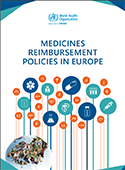Medicines reimbursement policies in Europe (2018)

Download
2018, xv + 183
ISBN 978 92 890 5336 5
This publication is only available online.
This report reviews and analyses different reimbursement policies for medicines applied by countries in the WHO European region. The study used a mixed methods approach including primary data collection through a questionnaire addressing the competent authorities included in the Pharmaceutical Pricing and Reimbursement Information (PPRI) network, a literature review, qualitative interviews with authorities and researchers in selected case study countries, and a cross-country analysis of the actual financial burden for patients.
The study found that while almost all countries provide full coverage for medicines in the inpatient sector, patients can be asked to co-pay for reimbursable medicines in the outpatient sector. As a commonly applied co-payment patients pay a defined share of the price of a medicine; in addition, prescription fees and/or deductibles are also in place in some countries. In the countries of the WHO European region, mechanisms have been established to protect defined population groups from excessive co-payments for medicines; key reasons for reductions of and exemptions from co-payments include low income, defined diseases or disabilities and age.
The analysis of the actual financial burden suggested that co-payments may pose a substantial financial burden for patients, particularly in lower-income countries. The report identified several principles aiming to improve affordable access to medicines and protect people from excessive out-of-pocket co-payments. These include clear priority-setting processes, evidence based decision-making, transparent processes, consideration of vulnerable population groups, making use of the efficiency of lower priced medicines, regular evaluations and strategic design of policy measures.



